Balkinization
an unanticipated consequence of
Jack M. Balkin
Balkinization Symposiums: A Continuing List
E-mail:
Jack Balkin:
jackbalkin at yahoo.com
Bruce Ackerman
bruce.ackerman at yale.edu
Ian Ayres
ian.ayres at yale.edu
Corey Brettschneider
corey_brettschneider at brown.edu
Mary Dudziak
mary.l.dudziak at emory.edu
Joey Fishkin
joey.fishkin at gmail.com
Heather Gerken heather.gerken at yale.edu
Abbe Gluck abbe.gluck at yale.edu
Mark Graber
mgraber at law.umaryland.edu
Stephen Griffin
sgriffin at tulane.edu
Jonathan Hafetz
jonathan.hafetz at shu.edu
Jeremy Kessler
jkessler at law.columbia.edu
Andrew Koppelman
akoppelman at law.northwestern.edu
Marty Lederman
msl46 at law.georgetown.edu
Sanford Levinson
slevinson at law.utexas.edu
David Luban
david.luban at gmail.com
Gerard Magliocca
gmaglioc at iupui.edu
Jason Mazzone
mazzonej at illinois.edu
Linda McClain
lmcclain at bu.edu
John Mikhail
mikhail at law.georgetown.edu
Frank Pasquale
pasquale.frank at gmail.com
Nate Persily
npersily at gmail.com
Michael Stokes Paulsen
michaelstokespaulsen at gmail.com
Deborah Pearlstein
dpearlst at yu.edu
Rick Pildes
rick.pildes at nyu.edu
David Pozen
dpozen at law.columbia.edu
Richard Primus
raprimus at umich.edu
K. Sabeel Rahmansabeel.rahman at brooklaw.edu
Alice Ristroph
alice.ristroph at shu.edu
Neil Siegel
siegel at law.duke.edu
David Super
david.super at law.georgetown.edu
Brian Tamanaha
btamanaha at wulaw.wustl.edu
Nelson Tebbe
nelson.tebbe at brooklaw.edu
Mark Tushnet
mtushnet at law.harvard.edu
Adam Winkler
winkler at ucla.edu
Compendium of posts on Hobby Lobby and related cases
The Anti-Torture Memos: Balkinization Posts on Torture, Interrogation, Detention, War Powers, and OLC
The Anti-Torture Memos (arranged by topic)
Recent Posts
Campaign Finance and Free Speech: The Extreme and the Mainstream
Just A Few Blogs
ACS Blog
Alas, a Blog
Althouse
Arts and Letters Daily
Atrios (Eschaton)
Bill of Health
Buzzflash.com
Buzz Machine
Cato at Liberty
Juan Cole (Informed Comment)
Concurring Opinions
The Constitution in 2020
Corrente
Crooked Timber
Daily Howler
Daily Kos
Dana Boyd
Brad DeLong
Digby (Hullabaloo)
Discriminations
Daniel Drezner
Kevin Drum (Mother Jones)
Electrolite
En Banc
Eunomia (Daniel Larison)
Fafblog
Michael Froomkin (Discourse.net)
GovLab (Beth Noveck)
Rick Hasen (Election Law)
History News Network
How Appealing
Ignatz (Sam Heldman)
The Importance of (Ernie Miller)
Infolaw
Instapundit
International Economic Law and Policy Blog
IntLawGrrls
Jacob Levy
Jesus' General
Jurisdynamics
The Kitchen Cabinet
Mark Kleiman
Law Blog Central
Larry Lessig
Lawyers, Guns and Money
Liberal Oasis
Brian Leiter's Law School Reports
The Leiter Reports
Marginal Revolution
Megan McArdle
Memeorandum
Metafilter
Mirror of Justice
The New Republic
Newseum
No More Mister Nice Blog
Brendan Nyhan
Opinio Juris
Orcinus
The Originalism Blog
Pandagon
Passport (Foreign Policy)
Overcoming Bias
Political Animal (Washington Monthly)
Political Theory Daily Review
Political Wire (Taegan Goddard)
The Poor Man
Virginia Postrel
Prawfsblawg
Public Reason
Jonathan Rauch
Raw Story
Redstate
ReligiousLeftLaw.com
Reporters Committee For Freedom of the Press
Reproductive Rights Blog
Rothman's Roadmap to the Right of Publicity
SCOTUS Blog
Seeing the Forest
Clay Shirky
The Shifted Librarian
The Situationist
Larry Solum (Legal Theory)
Andrew Sullivan
Talking Points Memo
Talk Left
Tapped
Tbogg
TechPresident
The Paper Chase (Jurist)
Tom Paine
Tom Tomorrow (This Modern World)
Eve Tushnet
Uggabugga
University of Chicago Law School Faculty Blog
Unqualified Offerings
The Volokh Conspiracy
War and Piece (Laura Rozen)
Wampum
Oliver Willis
Wonkette
Written Description
Matthew Yglesias
Yin
Your Choice of Feeds
1. XML
powered by
2. Atom Feed
3. RSS 2.0
Campaign Finance and Free Speech: The Extreme and the Mainstream
Guest Blogger
For the Balkinization symposium on Free Speech in Crisis and the Limits of the First Amendment. Bradley A. Smith It is often suggested that the
true test of one’s commitment to free speech and the First Amendment comes when
one is faced with “offensive” content or “extreme” views. I am not so sure. It seems to me that the ordinary
American can be forgiven for not thinking that the future of free speech hinges
on the ability to show videos of animals being tortured, to depict simulated
child pornography, or to engage in hate-filled protests at the funeral of a
deceased serviceman.[1]
The traditional argument for policing efforts to ban such speech is not that
not that this type of speech has much intrinsic value, but rather that these
outer fringes of the free speech must be protected in order to prevent inroads
into the core of First Amendment-protected speech. Put another way, we cannot
ultimately trust the government to censor such “low-value” speech, over time,
without invading the core. The average American, who responds to a pollster’s
question or a barstool quip without, perhaps, giving the issue much thought,
might, under the circumstances, be forgiven for lapses in First Amendment
purity. And in the great scheme of things—at least if by the “great scheme of
things” we’re talking democratic self-government—whether or not such speech is
limited is probably of little importance, unless and until the government uses
such limits as a lever to invade the core. If I am correct, then the true
test of one’s First Amendment bona fides
comes when speech is on the line that is not
patently offensive or does not
represent the extreme fringes of political discourse. It is when we encounter
speech that has greater value, that has the ability to affect public policy,
that may in fact shape our great experiment in democracy and self-government, but
with which we disagree or firmly wish was not stated, that the First Amendment rubber
truly meets the road. The Supreme Court has repeatedly
said, and I think most people would intuitively agree, that the core of the
First Amendment is political speech. “The First Amendment,” the Court has said,
“affords the broadest protection to such
political expression in order ‘to assure [the] unfettered interchange of ideas
for the bringing about of political and social changes desired by the people.’"[2]
"[T]here is practically universal agreement that a major purpose of that
Amendment was to protect the free discussion of governmental affairs, . . . of
course includ[ing] discussions of candidates. . . ."[3]
If I may take this one step further, the most important political speech is
that which may actually persuade, change electoral outcomes, or affect public
policy. This is where support for
campaign finance “reform,” or as I prefer to more properly label it, campaign
finance “regulation,” comes in. In my experience, many a “man on the street”
will react to a claim of constitutional protection against campaign finance
regulations by saying, “money is not speech.” But few who have really thought
about it—including that same “man on the street” after one or two questions and
a few moments thinking—will deny that campaign finance regulations deeply
embroil the First Amendment. That campaign finance regulation cuts at core
First Amendment liberties is not terribly controversial amongst scholars, and
certainly not amongst judges.[4] Despite this recognition, at
least the late 1960s, the political left—once the side of the political
spectrum most protective of speech rights—has vigorously sought to regulate
political speech through restrictions on the financing of political campaigns
and public discourse about politics. And in that time, the vast majority of
legal scholarship pertaining to campaign finance reform has been devoted to
explaining why this particular form of protected, “core” activity is either so
dangerous, or so important, that it must be regulated. Since the early 1970s, both the
federal government and the vast majority of states have implemented a variety
of regimes of heavy campaign finance regulation. Rarely in U.S. history has a
policy idea been so widely implemented, and yet so objectively failed to even
partially attain its objectives. Campaigns are not less expensive; candidates
do not spend less time fundraising; political debate has not been elevated;
special interest influence has not abated; political corruption has not been
effectively addressed; confidence in government has not risen; government does
not seem to be more responsive; polarization appears to have increased, not
decreased; and equality of political influence remains the chimera it has
always been. I do not suggest that all of these goals are, in my view,
inherently desirable. But all are well documented as objectives of “reform.” In
sacrifice to these goals, countless Americans have been caught in needless
legal snares for what was once routine political activism; campaigns have
become more centralized, to the detriment of true grassroots activities; and
specialists—accountants, lawyers, consultants, and ultimately appointed enforcement
bureaucrats—now play a larger and, for the most part, unhealthy, role in
politics. It may not be that campaign finance regulation is responsible for
these trends, but it certainly has not prevented any of them. But what is most unique about
campaign finance regulation is that it is not aimed at “offensive,”
“extremist,” or “low-value” speech—it is aimed directly at the mainstream
expression of views that happen to be inconvenient for, or disliked by, persons
who have the power to suppress that speech. Supporters of campaign finance
regulation typically react to this critique by asserting higher values—they support
the First Amendment, they say, but seek merely to guarantee political equality,
prevent the emergence of a ruling oligarchy, fight to assure that legislators
are responsive to the people, etc. But these are merely other ways of saying,
“yes, this core political speech ought not be protected by the First
Amendment.” Nor are regulatory proposals
saved by their (sometime) facial neutrality. While individual supporters may
honestly believe their proposals are neutral, as a political matter campaign
finance regulation always and everywhere devolves into a struggle to silence
the dissenting or inconvenient voices of the dominant group’s political
adversaries.[5]
Just as the burdens of a facially neutral law prohibiting all citizens from
sleeping under bridges will predictably fall on the poorest elements of society
while leaving its wealthier elements unscathed, so it is easy to create
“neutral” campaign finance rules that predictably and disproportionately target
one’s opponents. Thus, to use one of the broadest and most obvious examples,
Democrats have traditionally sought limits on corporations; Republicans on
unions. And if one knows how one’s adversaries gain influence, approach voters,
and fund their campaigns, one can pass “neutral” legislation that predictably
whacks one’s political rivals. To use a baseball analogy, if the other team has
long ball hitters, move the fences out; if your team’s ace throws a sinker, let
the grass grow long. All perfectly “content neutral” on the face of things, yet
designed to alter the outcome of the game in the home team’s favor. Worse, even
when legislators don’t intend to “rig” the campaign finance system, the rules
they propose will naturally tend, over time, to favor incumbents generally, and
the party in power in particular. This is because rules that have this effect
will tend to seem “fair” to those people, while rules that do not will be
considered a “problem for democracy.” Turning specifically to the
question posed by this symposium, I do not believe that free speech is in
crisis. But I do recognize disturbing trends that, if allowed to continue,
could develop into a crisis. One is the growing support for
limits on “offensive” speech, especially among the nation’s younger cohorts.[6]
Even this might not be cause for alarm, were it not accompanied by what seems
to be a growing willingness to define “offensive” down—to give just two
high-profile examples, a sitting federal judge was deemed too “extreme” or
“offensive” to speak at Stanford Law School, and a former Treasury Secretary in
the Clinton Administration, Lawrence Summers, met a similar fate (ironically,
in a class on “Democracy and Disagreement).”[7] Worse still may be the efforts of
government officials, and in particular the Biden Administration, to use
government pressure to censor speech that is, or at least ought to be, clearly
in the mainstream of political discourse, under the guise of “misinformation”
and “disinformation.” It is alarming that the Biden Administration established
a “Disinformation Governance Board,” (though encouraging that the Board was
quickly scotched after public outcry),[8]
and that even without such a Board, it blatantly and regularly pressured
private media platforms to censor speech ranging from disfavored policy
recommendations on the Covid pandemic, to unflattering descriptions of the
state of the economy, to concerns about “election integrity,” and even to simple
musings about Jill Biden.[9]
It is even more alarming that so many on
the left seemed—and still seem--utterly unconcerned by such developments. Now,
however, with Trump in charge, the left is panicked about statements and orders
from the Trump administration—many of which can reasonably be deemed efforts to
intimidate the opposition into silence—while many conservatives seem happy to
consider turnabout to be fair play. The political left of center, and
particularly opinion leaders in academia and press, have yet to come to grips
with these and other fundamental, anti-democratic misdeeds by the Democratic
Party and the political left. Since January 6, 2021, polls have regularly shown
that pluralities of Americans see the Democratic Party as a greater threat to
democratic governance than the Republican Party. But the voters have: exit
polls from the 2024 election showed that voters who believed democracy was
threatened were more likely to vote for Trump than for Kamala Harris.[10] Why is the state of things
accepted, with apparently large numbers on both sides open to these affronts so
long as they are aimed at the opposition? One cannot help but think it is, at
least in part, a natural result of 50 years of scholarship explaining why, in
the context of campaign finance, mainstream political speech is so important
that it should not be protected by the First Amendment, and thus one ought to
be able to pass legislation that limits the voices of those one thinks have
“too much influence” or “unfair” advantages. Chickens always come home to
roost. Fortunately, the Roberts Court
has been solicitous of free speech in the form of campaign spending and
contributions, often to near hysteria from the left.[11]
After all, a case such as Citizens United
v. Federal Election Commission [12]
was ultimately about whether the government could prohibit the distribution of
a documentary movie about a major political candidate merely because it was distributed
by a corporation—like every other movie you see on cable, streaming, or in the
theater. That it was a biased documentary—as was, for example, Michael Moore’s
2004 film Fahrenheit 9/11—is really
beside the point. Unless, of course, you think the government should be in the
business of deciding when a documentary is too biased and should be censored. Stunned by a series of campaign
spending and contribution decisions from both the Supreme Court and lower
courts, the “reform community” now has turned its glare on another First
Amendment right, one that, not that long ago, American liberals won only after
hard fought battles. I speak here of the right to privacy in one’s
associations. The idea that it is none of the government’s business what
charities, advocacy groups, and even partisan political organizations one
chooses to associate with, was won only after liberals took the lead against
the post-WWII “red scare.” In the era, the government sought, through
compulsory disclosure of political connections, support, and activity, to
facilitate the creation of “black lists.”[13]
That was followed by the legal fight against efforts by state governments to
knee-cap civil rights organizations by exposing their members and donors to
harassment and pressure;[14]
and eventually against efforts to enable retaliatory actions by government
officials against citizens with disagreeable opinions,[15]
including even members of major political parties in areas where they were in
the minority.[16] By the early 1970s, these rights
to privacy appeared to have sunk roots. But in Buckley v. Valeo[17]
and later decisions, the Supreme Court upheld an exception to the rights
involved where political campaigns were concerned—again, because this
mainstream speech and association was deemed so important that the government
had a “compelling” interest in regulating it. Speech, association, and privacy
advocates could, however, take some solace in the fact that these decisions
were for many years limited to direct gifts to candidates, political parties,
and political action committees (PACs), or to donations dedicated to funding
“explicit advocacy” of election or defeat of a candidate. Today, however, under the
populist guise of limiting “dark money,” exposing “original sources,” and blocking
“foreign influence,” activists on both the right but, much more so, the left
have sought to expand these compulsory disclosure rules to include support for
non-profit advocacy groups, trade associations, unions, and even charities. In
doing so, they do not target “offensive,” “obscene,” “extreme,” or “low-value”
speech. They are quite open that the objective is to burden the expression of
mainstream views that they find objectionable and assure that those speakers
are “held accountable.” If they succeed—and so far the courts have sent mixed
signals, although the Supreme Court’s 2021 decision in Americans for Prosperity
Foundation v. Bonta[18]
is a positive sign—they will undo the hard fought victories won by American
liberals in the post-war decades. To summarize, support for limits
or even bans on “extremist” or “offensive’’ speech, obscenity, violent speech, and
the like is, in my view, misguided, ignoring the dangers of granting government
this power, and the ability of those in power to define such speech down to
where it does cut into the core. But by itself, it does not suggest an
abandonment of public support for free speech. Support for limits on mainstream
political discourse that one finds disagreeable, inconvenient, or threatening
to one’s hold on power, however, is another story. Unfortunately, under the
guise of campaign finance “reform,” that is the dominant view among the legal scholars
whom we would, in a better world, expect to be on the barricades defending free
speech. If we are worried about a
long-term decline in support for free speech, I am less concerned about those
who would challenge it at the margins—speech that is truly “offensive” or
“extreme”—than those who attack it at its core—perfectly mainstream speech about
candidates and issues and that happens to be disagreeable to some persons’
notion of equality, or which is simply disagreeable or inconvenient to those in
power. Bradley A. Smith is Josiah H. Blackmore II/Shirley M. Nault Professor of Law, Capital University Law School. You can reach him by e-mail at bsmith@law.capital.edu. [1] See, respectively, United States v.
Stevens, 559 U.S. 460 (2010); Ashcroft v. Free Speech Coalition, 535 U.S. 234
(2002), and Snyder v. Phelps 562 U.S. 443 (2011). [2]
Buckley v. Valeo, 424 U.S. 1, 14 (1976) (quoting Roth v. United States, 354
U.S. 476, 484 (1957). [3] Mills v. Alabama, 384 U.S.
214, 218 (1966). [4]
Just to focus on the Supreme Court, 23 justices have at on the Court since the
seminal Buckley decision. With the
exceptions of Justice Jackson, who has not yet heard a campaign finance case,
and Justice Stevens, who abandoned the First Amendment analysis later in his
career, see Nixon v. Shrink Missouri
Government PAC, 528 U.S. 377, 398-399 (2000)(Stevens, J., concurring), all have accepted that these laws infringe on
First Amendment rights. The sometime bitter debates between them hinges on
whether they believe these infringements are justified by “compelling”
government interests. [5] See e.g. John Samples, The Fallacy of
Reform (2005); Paula Baker, Curbing Campaign Cash (2012). McConnell v. Federal
Election Commission, 540 U.S. 93, 248-250 (Scalia, J., dissenting in part). [6] See e.g. Jean M. Twenge, Young Liberals Used to be the Most
Supportive of Free Speech. Now They’re the Least, Generation Tech, Jan. 18,
2024 (at https://www.generationtechblog.com/young-liberals-used-to-be-the-most)(summarizing)
(summarizing recent polling data); Colleen McClain, More so Than Adults, U.S. Teens Value People Feeling Safe Online Over
Being Able to Speak Freely, Pew Research, Aug. 30, 2022 (at https://www.pewresearch.org/short-reads/2022/08/30/more-so-than-adults-u-s-teens-value-people-feeling-safe-online-over-being-able-to-speak-freely/). [7] See Sumarya Kalamanga, Behind the Story: Free Speech Controversy at
Stanford, NY Times, Apr. 12, 2023; Dylan Rem, Former Treasury Secretary Lawrence Summers Shouted Down During
Stanford’s ‘Democracy and Disagreement’ Class,
Stanford Review, Feb. 25, 2025. [8]
See Dept. of Homeland Security, Following HSAC Recommendation, DHS terminates
Disinformation Governance Board (Aug. 22, 2022) available at https://www.dhs.gov/archive/news/2022/08/24/following-hsac-recommendation-dhs-terminates-disinformation-governance-board. [9] See Missouri v. Biden, 680 F. Supp. 3d
630 (W.D. La. 2023), rev’d sub nom. on legal grounds, Murthy v. Missouri, 603 U.S. 43 (2024). Much of the targeted
speech turned out to be true, perhaps most notably the “Hunter Biden laptop”
story. [10] See e.g. Grinnell College National Poll,
Oct. 13-17, 2021; Marist Poll Staff, Trust in Elections and Threat to
Democracy, Nov. 1, 2021; CNN, Election 2024 Exit Polls, https://www.cnn.com/election/2024/exit-polls/national-results/general/president/0.
[11] See William R. Maurer, Illuminating Citizens United: What the
Decision Really Did, 12 Fed. Soc. Rev., Jan. 11, 2012 (compling a sampling
of reactions). [12]
558 U.S. 310 (2010). [13] See Barsky v. United States, 167 F. 2d
241, 246 (D.C. Cir. 1948); Lawson v. United States, 176 F.2d 4 (D.C. Cir. 1950);
Sheldon v. Tucker, 364 U.S. 479 (1958). [14]
NAACP v. Alabama, 357 U.S. 449 (1958); Gibson v. Florida Legislative
Investigation Committee, 372 U.S. 539 (1963); Louisiana v. NAACP, 366 U.S. 293
(1961); [15]
McIntyre v. Ohio Elections Commission, 514 U.S. 334 (1995); Talley v.
California, 362 U.S. 60 (1960). [16]
Pollard v. Roberts, 283 F. Supp. 248 (D. Ark. 1968), sum. aff’d 394 U.S. 14 (1968). [17]
424 U.S. 1 (1976). See also e.g. McConnell v. Federal Election Commission, 540
U.S. 93 (2003); Citizens United v. Federal Election Commission, 558 U.S. 310
(2010). [18]
141 S. Ct. 2373 (2021).
Posted
9:30 AM
by Guest Blogger [link]
Books by Balkinization Bloggers

Linda C. McClain and Aziza Ahmed, The Routledge Companion to Gender and COVID-19 (Routledge, 2024)

David Pozen, The Constitution of the War on Drugs (Oxford University Press, 2024)

Jack M. Balkin, Memory and Authority: The Uses of History in Constitutional Interpretation (Yale University Press, 2024)
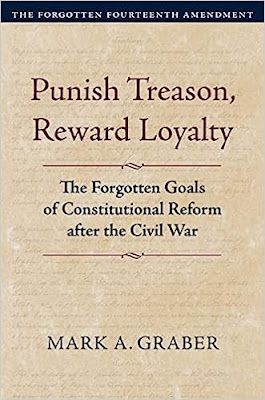
Mark A. Graber, Punish Treason, Reward Loyalty: The Forgotten Goals of Constitutional Reform after the Civil War (University of Kansas Press, 2023)
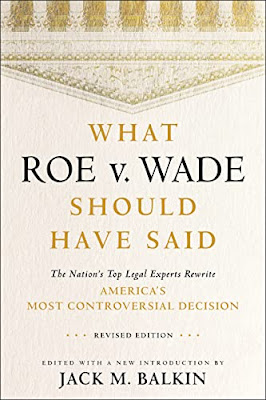
Jack M. Balkin, What Roe v. Wade Should Have Said: The Nation's Top Legal Experts Rewrite America's Most Controversial Decision - Revised Edition (NYU Press, 2023)

Andrew Koppelman, Burning Down the House: How Libertarian Philosophy Was Corrupted by Delusion and Greed (St. Martin’s Press, 2022)

Gerard N. Magliocca, Washington's Heir: The Life of Justice Bushrod Washington (Oxford University Press, 2022)
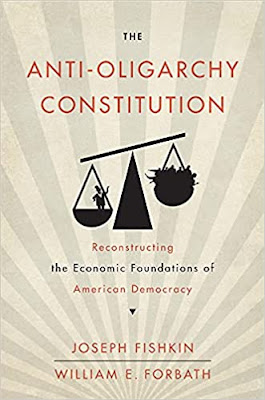
Joseph Fishkin and William E. Forbath, The Anti-Oligarchy Constitution: Reconstructing the Economic Foundations of American Democracy (Harvard University Press, 2022)

Mark Tushnet and Bojan Bugaric, Power to the People: Constitutionalism in the Age of Populism (Oxford University Press 2021).

Mark Philip Bradley and Mary L. Dudziak, eds., Making the Forever War: Marilyn B. Young on the Culture and Politics of American Militarism Culture and Politics in the Cold War and Beyond (University of Massachusetts Press, 2021).

Jack M. Balkin, What Obergefell v. Hodges Should Have Said: The Nation's Top Legal Experts Rewrite America's Same-Sex Marriage Decision (Yale University Press, 2020)

Frank Pasquale, New Laws of Robotics: Defending Human Expertise in the Age of AI (Belknap Press, 2020)

Jack M. Balkin, The Cycles of Constitutional Time (Oxford University Press, 2020)

Mark Tushnet, Taking Back the Constitution: Activist Judges and the Next Age of American Law (Yale University Press 2020).

Andrew Koppelman, Gay Rights vs. Religious Liberty?: The Unnecessary Conflict (Oxford University Press, 2020)

Ezekiel J Emanuel and Abbe R. Gluck, The Trillion Dollar Revolution: How the Affordable Care Act Transformed Politics, Law, and Health Care in America (PublicAffairs, 2020)

Linda C. McClain, Who's the Bigot?: Learning from Conflicts over Marriage and Civil Rights Law (Oxford University Press, 2020)
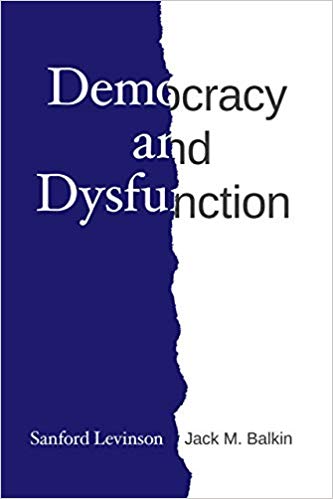
Sanford Levinson and Jack M. Balkin, Democracy and Dysfunction (University of Chicago Press, 2019)

Sanford Levinson, Written in Stone: Public Monuments in Changing Societies (Duke University Press 2018)

Mark A. Graber, Sanford Levinson, and Mark Tushnet, eds., Constitutional Democracy in Crisis? (Oxford University Press 2018)

Gerard Magliocca, The Heart of the Constitution: How the Bill of Rights became the Bill of Rights (Oxford University Press, 2018)

Cynthia Levinson and Sanford Levinson, Fault Lines in the Constitution: The Framers, Their Fights, and the Flaws that Affect Us Today (Peachtree Publishers, 2017)

Brian Z. Tamanaha, A Realistic Theory of Law (Cambridge University Press 2017)

Sanford Levinson, Nullification and Secession in Modern Constitutional Thought (University Press of Kansas 2016)

Sanford Levinson, An Argument Open to All: Reading The Federalist in the 21st Century (Yale University Press 2015)

Stephen M. Griffin, Broken Trust: Dysfunctional Government and Constitutional Reform (University Press of Kansas, 2015)

Frank Pasquale, The Black Box Society: The Secret Algorithms That Control Money and Information (Harvard University Press, 2015)

Bruce Ackerman, We the People, Volume 3: The Civil Rights Revolution (Harvard University Press, 2014)
Balkinization Symposium on We the People, Volume 3: The Civil Rights Revolution

Joseph Fishkin, Bottlenecks: A New Theory of Equal Opportunity (Oxford University Press, 2014)

Mark A. Graber, A New Introduction to American Constitutionalism (Oxford University Press, 2013)

John Mikhail, Elements of Moral Cognition: Rawls' Linguistic Analogy and the Cognitive Science of Moral and Legal Judgment (Cambridge University Press, 2013)

Gerard N. Magliocca, American Founding Son: John Bingham and the Invention of the Fourteenth Amendment (New York University Press, 2013)

Stephen M. Griffin, Long Wars and the Constitution (Harvard University Press, 2013)

Andrew Koppelman, The Tough Luck Constitution and the Assault on Health Care Reform (Oxford University Press, 2013)

James E. Fleming and Linda C. McClain, Ordered Liberty: Rights, Responsibilities, and Virtues (Harvard University Press, 2013)
Balkinization Symposium on Ordered Liberty: Rights, Responsibilities, and Virtues

Andrew Koppelman, Defending American Religious Neutrality (Harvard University Press, 2013)

Brian Z. Tamanaha, Failing Law Schools (University of Chicago Press, 2012)

Sanford Levinson, Framed: America's 51 Constitutions and the Crisis of Governance (Oxford University Press, 2012)

Linda C. McClain and Joanna L. Grossman, Gender Equality: Dimensions of Women's Equal Citizenship (Cambridge University Press, 2012)

Mary Dudziak, War Time: An Idea, Its History, Its Consequences (Oxford University Press, 2012)

Jack M. Balkin, Living Originalism (Harvard University Press, 2011)

Jason Mazzone, Copyfraud and Other Abuses of Intellectual Property Law (Stanford University Press, 2011)

Richard W. Garnett and Andrew Koppelman, First Amendment Stories, (Foundation Press 2011)

Jack M. Balkin, Constitutional Redemption: Political Faith in an Unjust World (Harvard University Press, 2011)

Gerard Magliocca, The Tragedy of William Jennings Bryan: Constitutional Law and the Politics of Backlash (Yale University Press, 2011)

Bernard Harcourt, The Illusion of Free Markets: Punishment and the Myth of Natural Order (Harvard University Press, 2010)

Bruce Ackerman, The Decline and Fall of the American Republic (Harvard University Press, 2010)
Balkinization Symposium on The Decline and Fall of the American Republic

Ian Ayres. Carrots and Sticks: Unlock the Power of Incentives to Get Things Done (Bantam Books, 2010)

Mark Tushnet, Why the Constitution Matters (Yale University Press 2010)
Ian Ayres and Barry Nalebuff: Lifecycle Investing: A New, Safe, and Audacious Way to Improve the Performance of Your Retirement Portfolio (Basic Books, 2010)
.jpg)
Jack M. Balkin, The Laws of Change: I Ching and the Philosophy of Life (2d Edition, Sybil Creek Press 2009)

Brian Z. Tamanaha, Beyond the Formalist-Realist Divide: The Role of Politics in Judging (Princeton University Press 2009)
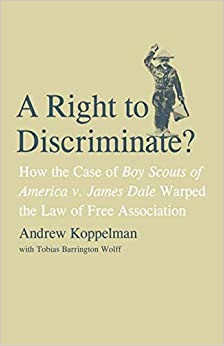
Andrew Koppelman and Tobias Barrington Wolff, A Right to Discriminate?: How the Case of Boy Scouts of America v. James Dale Warped the Law of Free Association (Yale University Press 2009)

Jack M. Balkin and Reva B. Siegel, The Constitution in 2020 (Oxford University Press 2009)
Heather K. Gerken, The Democracy Index: Why Our Election System Is Failing and How to Fix It (Princeton University Press 2009)

Mary Dudziak, Exporting American Dreams: Thurgood Marshall's African Journey (Oxford University Press 2008)

David Luban, Legal Ethics and Human Dignity (Cambridge Univ. Press 2007)

Ian Ayres, Super Crunchers: Why Thinking-By-Numbers is the New Way to be Smart (Bantam 2007)

Jack M. Balkin, James Grimmelmann, Eddan Katz, Nimrod Kozlovski, Shlomit Wagman and Tal Zarsky, eds., Cybercrime: Digital Cops in a Networked Environment (N.Y.U. Press 2007)

Jack M. Balkin and Beth Simone Noveck, The State of Play: Law, Games, and Virtual Worlds (N.Y.U. Press 2006)

Andrew Koppelman, Same Sex, Different States: When Same-Sex Marriages Cross State Lines (Yale University Press 2006)
Brian Tamanaha, Law as a Means to an End (Cambridge University Press 2006)
Sanford Levinson, Our Undemocratic Constitution (Oxford University Press 2006)
Mark Graber, Dred Scott and the Problem of Constitutional Evil (Cambridge University Press 2006)
Jack M. Balkin, ed., What Roe v. Wade Should Have Said (N.Y.U. Press 2005)
Sanford Levinson, ed., Torture: A Collection (Oxford University Press 2004)
Balkin.com homepage
Bibliography
Conlaw.net
Cultural Software
Writings
Opeds
The Information Society Project
BrownvBoard.com
Useful Links
Syllabi and Exams